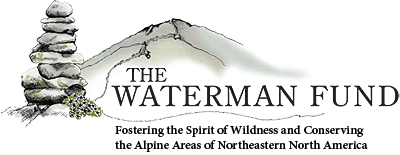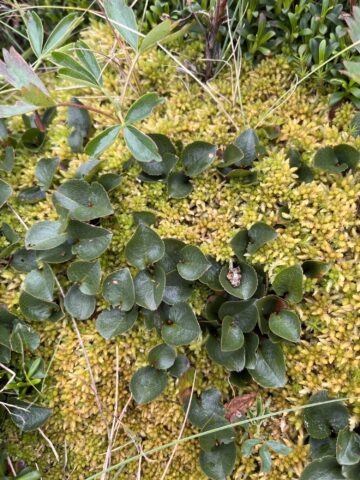Summit Stewards Discover Rare Plant on Algonquin Peak
From the 2023 Alpine Steward, the annual newsletter of the Waterman Fund:
“Summit Stewards Discover Rare Plant on Algonquin Peak”
On August 15, Adirondack Mountain Club (ADK) Summit Steward Katie Leton was above treeline on Algonquin Peak, New York’s second highest peak, diligently scanning the ground. She was searching for penny sized, deep green leaves, each folded inward into a shallow cup. Within an hour, to hers and her team’s astonishment, she had found it—Dwarf willow, one of the rarest plants in New York State.
Dwarf willow (Salix herbacea) is a very tiny shrub, only one half to five centimeters tall, that grows in colonies, with trunks and main branches underground and only the upper branchlets sticking above the ground. According to the New York Natural Heritage Program, the plant occurs in snowbeds and other protected places, such as seeps at the base of cliffs.
The plant’s range is restricted to the highest peaks of northern New England, making it one of the rarest alpine plants in the region. In New York, where it is listed as Critically Imperiled, it was believed to have been limited to a single population on Mount Marcy. A historic record from 1980 noted a population on Algonquin Peak, but a thorough search conducted in 1988 yielded no results. Until Leton’s discovery, Dwarf willow was considered extirpated there.
“The rediscovery of this tiny plant on Algonquin after an absence of many decades is very exciting and indicates better prospects for this species to persist in New York,” said Richard Ring, Chief Botanist for the New York Natural Heritage Program [NYNHP]. “It is also a testament to the Summit Stewardship Program’s persistent efforts to steward the recovery of the unique and fragile alpine ecosystems atop all New York’s High Peaks, which provide a home to this willow and many other rare species. It is wonderful to have an example of successful conservation and stewardship at such a heavily visited site.”
The discovery comes within a year of another significant find, when during a field trip at the Northeast Alpine Stewardship Gathering last October, ADK Summit Steward Coordinator Liam Ebner rediscovered Purple crowberry (Empetrum atropurpureum) on Mount Mansfield, Vermont. The plant was thought by state botanists to have been extirpated from the mountain, not seen since 1906.
These recent finds are a testament to the value of not only preserving remote mountain landscapes as a refuge for biodiversity, but also that of trained observers, such as summit stewards, who spend time in those places and come to know them intimately. Through hours, days, and weeks of attention, stewards notice things that many others do not. Though, for the most part, they are not formally
trained botanists, stewards are often the people best placed to monitor them. As climate change continues to bring unpredictable changes to alpine areas of the Northeast, such an eye for subtlety will be a crucial asset.
To finish reading the entire article, check out our 2023 Alpine Steward

